Busan
Busan (부산(釜山)) (formerly romanized as Pusan) is a city located in the south-eastern province of South Gyeongsang, South Korea. It is the second largest city in South Korea, and has the largest port in the country (5th largest in the world), biggest department store in the world, beautiful beaches and mountains, spas, and tasty seafood dishes.
Busan's many unique beaches attracts tourists from all over the South Korea, especially in the summer. But the beach is not the only thing to see in Busan. The vibrant seafood market in Jagalchi is the most famous seafood market in Korea, and walking through the old part of the city such as the Gamcheon offers the cozy atmosphere. It is also home to many events and festivals, such as the Busan International Film Festival, one of the most famous film festivals in Asia.
Districts
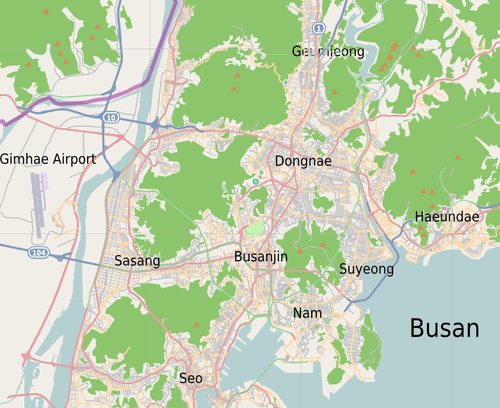
| Haeundae Upmarket residential and tourist area of Busan, boasting the main beaches and the most luxurious hotels. |
| Suyeong Famous for Gwangalli Beach and the Gwangan Bridge. |
| Central Busan The historical heart of the city, with the downtown areas of Busan-jin, Seomyeon and Jalgachi market. |
| North Busan Peace and mountains with the Beomoesa temple and the Geumjeong fortress |
| West Busan Nature reserves in and around the industrial outskirts. Contains Gimhae town, Gimhae International Airport and Sasang |
Understand
Located at the southern tip of the Korean peninsula and with over 3.6 million people, Busan is South Korea's second largest city and is known for its beaches, local seafood and events such as the city's renowned international film festival. It appeals to those seeking a more laid back atmosphere than Seoul as well as possessing an international flair, with sailors from around the world trooping through and a growing number of tourists.
The Haeundae area of Busan that contains a large amount of the city's attractions is described in a separate article.
| Busan | ||||||||||||||||||||||||||||||||||||||||||||||||||||||||||||
|---|---|---|---|---|---|---|---|---|---|---|---|---|---|---|---|---|---|---|---|---|---|---|---|---|---|---|---|---|---|---|---|---|---|---|---|---|---|---|---|---|---|---|---|---|---|---|---|---|---|---|---|---|---|---|---|---|---|---|---|---|
| Climate chart (explanation) | ||||||||||||||||||||||||||||||||||||||||||||||||||||||||||||
| ||||||||||||||||||||||||||||||||||||||||||||||||||||||||||||
| ||||||||||||||||||||||||||||||||||||||||||||||||||||||||||||
Climate
Busan has a sub-tropical climate with a hot humid summer and autumn along with a mild winter. Busan typically doesn't experience snow.
Orientation
Busan sits roughly 450 km (280 miles) southeast of Seoul and about 150 km (93 miles) northwest of Japan's main islands.
Nampodong to the south is Busan's shopping and entertainment downtown, while central Seomyeon at the intersection of metro lines 1 and 2 is the main office building area. Between them are Busan's train station and its international ferry terminals. The beaches of Gwangalli, Haeundae and Songjeong lie to the east, the ruins of mountain fortress Geumjeong guard the north. To the west is Gimhae town where the Busan Airport is located.
The eastern district of Haeundae is the most accessible area for foreigners, and many of Busan's attractions can be found here making it a good base to start exploring the city.
Get in
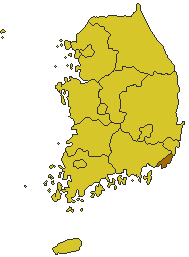
By plane
- Main article: Gimhae International Airport
Busan's International Gimhae Airport (PUS IATA) lies outside Busan, offering flights to many international destinations, and domestic routes to Jeju island, Seoul Incheon International Airport, Seoul Gimpo and Yang Yang. Seoul-Busan used to be among the world's busiest air routes, but since the introduction of KTX high speed train service, the number of flights has decreased quite a bit.
There are many options getting to airport from Busan, including Metro train, Limousine bus, local buses and taxis. (See Main article)
- Alternative Connect from Seoul Incheon An alternative to flying into Gimhae airport is to fly to Seoul Incheon International Airport, take the fast airport train to Seoul station and then take the high speed KTX train directly to Busan station. (Tickets to Busan can be purchased in the Arrivals area of Incheon airport.) The journey will take about four to five hours. For comparison, changing by train or limousine to Gimpo domestic airport, waiting, flying to Gimhae and then getting into Busan city will take the same amount of time.
- Alternative Connect from Seoul Gimpo is the same as Seoul Incheon except that the train journey to Seoul Station is shorter. KTX tickets would have to be purchased in Seoul Station.
By train
Busan is very well connected on the Korean rail network and a main hub for the fast and efficient KTX trains.
KTX trains connect Seoul to Busan via Daegu and Daejeon. Journey times vary between 120 to 150 min (₩55,500). Tickets can be purchased at the counter but automated English-language machines are available to make purchases with too.
Tickets can also be purchased on the Internet Korail site with an international credit card and picked up at most stations. This is very useful when planning to travel at peak times, when all tickets can quickly sell out. You can pick up your ticket at the closest station beforehand if you prefer.
KTX passengers are expected to be quiet but this is not always the case. First-class provides a more comfortable seat and the upgrade can be purchased en route. Snacks can be purchased on the trains using the vending machines or from an attendant. Each car has a free Wi-fi connection that is fast although can cut out in tunnels.
Other trains, such as Saemaeul and Mugunghwa connect Busan with other major cities as well. They're cheaper although much slower than KTX.
- Busan Station looks like a UFO that has accidentally landed in the somewhat grubby stretch between the bright lights of Nampodong and Seomyeon. The Busan 'China Town' is next to it, and Chinese dumplings are easily available. It's easy enough to get in or away on Metro Line 1, and there are lots of cheap motels and eating places in the vicinity. Downstairs from the ticket hall are a limited number of lockers, but these can quickly become occupied on busy days. At night this area could be considered dangerous by Busan very safe standards .
- Gupo Station is also in Busan. It's a 1-minute walk from the Gupo Metro Station on Metro Line 3. It's much smaller than Busan Station and usually uncrowded. A ticket from Gupo to Seoul is ₩1,000 cheaper than a ticket from Busan Station to Seoul. Gupo Station is ideal if you are coming or going from a place far away from Busan Station, such as Hwamyeongdong. This is also the closest KTX station to Busan Airport.
By car
Driving and parking in Busan can be difficult, so if you just want to look around the city then public transportation will be easier. However if you are coming to explore the area around Busan (such as going down to Geoje) then the flexibility of driving yourself will help you enjoy it more.
You can use the Hanero Card to pay toll gates in the city.
Busan is connected by three main highways:
By bus
Almost all cities and counties in South Korea have an express bus to Busan. There are two major bus stations:
- Dongbu Intercity Bus Terminal (동부시외버스터미널), Nopo Station (Line 1). For points north and east (e.g. Daegu, Gyeongju, Seoul, Ulsan).
- Seobu Intercity Bus Terminal (서부시외버스터미널), Sasang Station (Line 2). For points west (e.g., Jinju, Masan, Geoje Island).
- Busan Airport Long distances buses operate from directly outside the terminals of Gimhae (Busan) Airport to the cities of Changwon, Masan, Gimhae, Geoje, Tongyeong, Gyeongju, Pohang, Daegu, Gumi and Ulsan.
By boat
- Port of Busan. As well as a large comercial container port, also International Passenger Terminal, Cruise Terminal and Coastal Ferry Terminal.
Busan has regular international ferry services to Japan. Go to the International Ferry Terminal (Metro Line 1: Jungang-dong. Go right from exit 10) where you can book tickets to Japan, as well as Japan Rail tickets.
From Japan
- Tsushima island is the only part of Japan that is sometimes visible from Busan. It is known as Daemado Island in Korean. Ferries operated by Dae-a Express Shipping, carries passengers between Busan and Hitakatsu in 1 hour 40 minutes and between Busan and Izuhara in 2 hours 40 minutes.
- Fukuoka JR Kyushu's Beetle hydrofoils run five times a day and take just under 3 hours. The cost of flying from Busan is comparable to the hydrofoil. Alternatively a normal ferry takes 7 hours.
- Shimonoseki is 13 hours by overnight ferry with Kanpu Ferry.
- Osaka is even further, at 19 hours total journey time.
Domestic
The car ferry from Busan to Jeju island has been resumed as of April 2013. The journey takes 11 hours and travels every day except Sunday. Details can be found here or call the Coastal ferry terminal under: (051) 400-3142.
There used to be ferries to Geoje island, although due to a new road expressway they have been discontinued.
Get around
Hanaro Card
The Busan Hanaro Card (하나로카드) is a very useful travel card system that can be used on:
- Metro
- Light rail (such as to the airport)
- Taxis
- Local buses
- Local road toll ways (Such as Gwangallli Bridge)
The card costs ₩6000, which you then charge with value at kiosks located in almost every metro station.
Some convenience stores also allow you to recharge a card, although not all Hanaro card types are accepted,
You can also buy "cell phone jewelry" which is the same card except they can be attached to a mobile phone or key chain and can be used the same way. Prices for these vary, and they come in innumerable designs. Stations sell them in vending machines.
Using the Hanaro card will save you some money. The minimum metro fare is reduced from ₩1100 to ₩990. A local bus is reduced from ₩1200 to ₩1080.
When leaving a bus you can 'scan out' in order to have a discounted fare when you board another bus if within 20 minutes.
Furthermore, when you "scan out" from a metro and "scan in" to a bus within 20 minutes then the bus fare is reduced to ₩250.
By metro
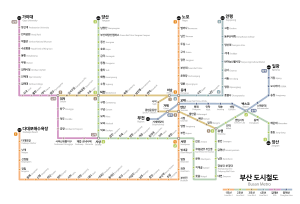
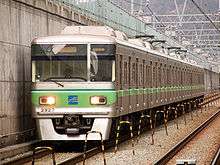
The four lines of the Busan Metro ( 1 2 3 4 ) can connect you to most places of interest in Busan. Other rides include Donghae and BGL (Busan-Gimhae Light Rail). Rides are ₩1200 or ₩1400 depending on distance (hang onto your ticket until you exit), and both signage and announcements are in English so finding your way is easy. An one-day ticket costs ₩4000.
Check carefully the direction you want to go, since once you go through the gate it may not be possible to change platforms in many stations. For example, the Green line (2) goes between Jangsan and Yangsan which is confusing to begin with.
Metro cars have specially designated seats (with obvious green stickers) for elderly, disabled and pregnant passengers. You can sit in them as long as you are prepared to give up your seat to someone who needs it.
If you are staying for a bit then consider buying a Hanaro card (하나로카드). T-money cards and some other metro cards for other cities also work for the Busan metro.
By light rail
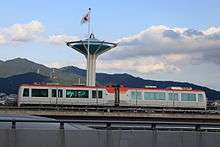
The BGL meets up with lines 2 and 3 . The light rail provides a convenient way for transiting to Gimhae International Airport. Apart from the airport and Gimhae town, there are not many places of interest on this line. The light rail ticketing is not integrated with the Busan Metro, and therefore a separate ticket is required to change between them. The Hanaro card can still be used to pay for tickets.
By train
There are dedicated train stations around the city of Busan however the locations are not great and frequency of trains is low. It is almost always preferable to take the metro or bus. For example you could take a train from Busan station to Haeundae station, however it would be more convenient to take the metro.
By taxi
There are plenty of taxis prowling the streets of Busan. Flag drop is ₩2200 for the first two kilometers, then the meter starts ticking at ₩100 for each 143 m or every 34 seconds if the taxi is going under 15 kph. Deluxe "mobeom" taxis (coloured black and red) charge ₩4500 for the first 3 km and then ₩200 for each 160 m or 38 seconds. Fares increase by 20% between midnight and 4AM.
If you look like a foreigner, then you are liable to be directed towards a black "mobeom" at a popular taxi rank. There is no problem however to use a cheaper 'plain' taxi instead.
You can use the Hanaro public transport card to pay for taxis as well. There is however no discount.
Most taxi drivers do not speak English, although some may speak Japanese, so if you can show the name in Korean of your destination it will help a lot. In Busan almost all taxi drivers are friendly towards foreigners, although they often assume that a foreigner wants to go a long distance such as to the airport.
Finding and catching a taxi in good weather is easy. When it is raining then you will be waiting a very long time before an available taxi stops for you.
There are some unscrupulous taxis that may attempt to charge much higher fixed fares, as much as ₩20,000, in some areas such as around the Busan port area. Insist on the meter and take a different taxi if your driver refuses to use it.
By bus
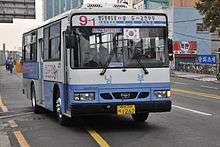
Busan has a good, efficient and comprehensive city bus system, although unlike the metro system it is only in Korean which makes it very challenging for foreigners to use. The front of the bus has the destination displayed in Korean, English and Japanese. Inside the bus the route maps are only in Korean, and the bus driver is unlikely to be able to speak English. If you plan to spend a long time in Busan then it is definitely worth learning how to use since it will open up locations to you that are not seen by most tourists.
Bus fares are ₩1,200 (1,080 with a Hanaro card) for local buses (colored blue or green), and ₩1,800 (1,700 with a transportation card) for chwaseok (seated) or express buses.
It is worth using a Hanaro card (see Metro Section) since these can be used for transfers between buses and metro trains: just swipe your card when leaving the bus.
The front seats of the bus have yellow seat covers, which mean they are designated for elderly, pregnant or disabled people. You are allowed to sit as long as you give it up when a more deserving person boards.
The ride on the bus can be very bumpy on Busan's hills, therefore at rush hour you may find yourself standing up for a long journey and swaying about the whole time!
The Busan municipal government publish a smart phone application for Android - 부산버스 (Busan Bus) - that makes planning your bus journey very easy (provided you can read basic Korean). You can enter your origin and destination in Busan, and it will provide the fastest route with real time updates on the location of the bus.
By bike
South Korean cities do not have a bicycle culture and the streets of Busan are not particularly safe for cyclists (Drivers are not used to them). The only options for this are in the touristic Haeundae district.
On foot
Due to the mountains and valleys, Busan lacks a natural city center and is very much spread out in every direction. This means that walking around the city is impractical.
However certain sights are clustered together in a way that makes walking around them possible.
- Haeundae: Start at the beach, turn right and walk around Dongbaek island and then explore the town.
- Romantic Road: Start at Haeundae beach, turn left and walk to the start of Dalmaji Hill, and then walk along the MoonTan road at the top.
- Jungang: Explore the old town around the '40 steps', and then walk to Yongdusan park and Busan Tower.
- Centum City: Bexco, Shinsigae Shopping Mall, Busan Cinema Center and the Busan Museum of Modern Art are all located around the Centum City metro station on the Green Line (Line 2)
Talk
- See also: Korean phrasebook
English in Busan is not quite as widely understood as it is in Seoul although still people should know enough to help you out. Taxi drivers are unlikely to have much English knowledge, although there is a translation service the taxi driver can call up if needed. Owing to the sizable number of Japanese tourists visiting Busan, knowing even limited Japanese may be useful since this is often understood by people working in hotels, restaurants and taxis.
Busan has a strong and distinct dialect that may be a little hard to understand if you have been studying Korean in Seoul. However, everyone in Busan will be able to understand a Seoul accent.
See
See the Districts articles for more listings.
|
Busan attractions in Haeundae
|
East Busan
- The Haeundae area in East Busan is the main tourist destination of the city and is described in its own article.
- The Suyeong (Gwangalli) area in East Busan is another noteworthy destination of the city and is described in its own article.
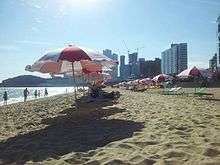
Central Busan
|
Attractions in Central Busan
|
This is the old town of Busan with a lot of post-war buildings, large docks and atmosphere. This is the place to go see the heritage of the city. The Central Busan is described in its own article.
North Busan
Easy to overlook, the north part of the city has few tourist attractions. Nevertheless it offers excellent hiking opportunities, the famous Beomeosa Temple as well as vibrant student life around the PNU university.
West Busan
The western part of the city is full of industrial parks leading to docks and the airport. There are however some nature areas preserved, such as the Nakdong River Estuary Migratory Bird Sanctuary and Taejongdae Park.
Do
See the Districts articles for more listings.
Events
As Korea's second largest city, there are a large number of events. The online Busan Haps magazine has a listing of new events in English.

- The Busan International Film Festival. Typically runs the first 10 days every year in October. It takes place all across Busan showcasing many international films and often some significant premieres of new Korean films. Most of the events are held on Haeundae beach where there are many tents promoting the industry as well as public interviews with stars. The Busan Cinema Center opened in 2011 to support this event. Tickets sell out quickly, and very long queues can be seen outside cinemas in the early morning for people wanting to catch the most anticipated films. (It used to be called the Pusan International Film Festival.)
- Polar Bear Swim, Haeundae Beach. A famous beach swim in the first week of January when the temperature is around 0°C. Hundreds of brave participants compete the cold in the sea. This event has run annually at the Choseon Beach Hotel since 1988.
- Busan International Rock Festival, Samrak Park. Busan has been holding an annual Rock festival for 12 years now in August. Mostly Korean and Asian rock bands although some Western bands do appear.
- Sea Art Festival 2013, Songdo Beach. An art festival held on the beach every year from mid-September to mid-October.
Hiking
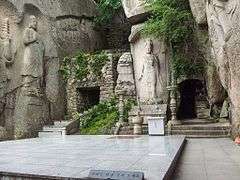
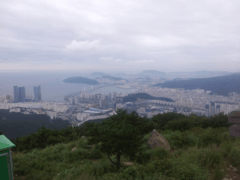
The mountains around Busan have some good hiking trails. Hiking trails are not really well marked in Korea, even if you can read Korean script. Definitely do your research before you hike.
Hiking clothes are a must have fashion item in Korea these days, even if they only get used in the local mall. Prices are extremely high, so you should purchase what you need before coming to Korea.
- Geumjeong Fortress. A popular route is to take the metro to Oncheongjang, and then a short taxi ride to the cable car station. At the top of the mountain head towards the South Gate (Nammun) of Geumjeong Fortress and then through the North Gate (Bukmun) and down to Beomeosa Temple. This has a distance of 9 km (Taking between 3 to 4 hours).
- Seokbulsa temple (석불사). Another impressive temple about 90 minutes hike from the cable car station. It is often overlooked, but has magnificent statues carved into the mountain itself. Great views over Busan and very peaceful. From the South Gate (남문), the path indicated by the Mandeokchon (만덕촌) sign leads to a collection of restaurants and volleyball courts in Namman Village (남만 마을). At one point, the path stops at a court; walk right and pick up the trail on the other side. About 500 m down the trail look for a sign that reads in Korean 석불사 입구 (Seokbulsa entrance). You will come to a steep mountain road. Turn right and walk the road 600 m uphill to the temple.
- Jangsan Mountain. If you are near Haeundae, then Jangsan mountain can provide a good day's hiking. There are military bases at the summit, complete with minefields but these are clearly marked and fenced off, and great views over Busan and on a clear day to Japan. A good starting point is Daecheon Park in Jangsan. A hike to the summit and back should take 3–4 hours.
Cinemas
Busan has a strong reputation for film, holding the Busan International Film Festival every year. There are cinemas in every area of the city, although unfortunately it is hard to find Korean films with English subtitles. The film festival being an exception to this.
It is really hard to get tickets to the Busan International Film Festival. People wait outside festival ticket offices for hours hoping to get something, so do some planning before traveling to Busan just for this. Haeundae beach has a public red carpet event at the beginning of the festival where you can see Korean film stars and hear them being interviewed.
Sports
- Baseball Busan is home to the 'Lotte Giants' team, and home games are held at Sajik Baseball Stadium.
- Basketball The Busan KT Sonicboom team is based in Sajik Arena.
- Football (Soccer)
- K-League: The Busan I'Park football (soccer) team is based in the Asiad Main Stadium.
- N-League: The Busan Transportation Corporation football team is based at the Gudeok Stadium in Dongdaesin. They have a dedicated and regular foreigner following.
- Busan Sailing. Haeundae has the largest leisure marina in Korea located about 10 minutes away from the beach walking in the direction of the Chosun Beach Hotel.
- Chicago Fitness Club. Is a great place to train. It has a wide range of cardio equipment, free weights (dumbbells up to 100 lb/45 kg) and machines as well as golf practice facilities. It is located on the 5th floor of the Milligore Shopping Center in Seomyeon.
- Busan Bandits Rugby Football Club. An expat rugby club open to all residents of Busan and surrounding provinces. They play mainly 10's rugby and compete in the Korean Expat Rugby League (KERA). No previous experience required.
Learn
- KLIFF provides flexible Korean language lessons in Haeundae near the beach and in the PNU university area in the north of the city.
Work
Positions teaching English are available in Busan. See the main South Korea article for details.
The Busan municipal government decided in early 2012 to phase out foreign teachers from English teaching positions in public schools. This means that English teaching opportunities will be mostly limited to the privately run Hagwons.
The online Busan Haps magazine has classified adds for such positions in Busan. The majority of positions are in the Haeundae district in the east, and many ESL teachers can be seen on the street around here.
Busan is much more limited than Seoul for general working opportunities. This mainly because English is less widely spoken and the city lacks the industries where foreigners can contribute such as finance and IT. If you are an engineering background there are usually a few opportunities listed on LinkedIn.
Buy
See the Districts articles for more listings.
Currency exchange is possible near Nampo-dong and Hauendae at banks such as KB (Korea Bank of Exchange), BS Bank (Busan Bank) and NH Bank. Withdrawing cash at an ATM with your foreign MasterCard or Visa is usually simple, with most cash machines have an English language option. American Express cards are more difficult to use.
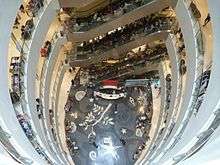
Eat
See the Districts articles for more listings.
Korea is justly renowned for its great seafood tradition, and Busan as Korea's main coastal city provides possibly the best opportunity to try fresh seafood caught locally.
Jagalchi fish market where most of the seafood is landed. You can turn up at 7AM for delicious grilled fish and a variation of Korean 'hangover soup', although many experiences at both the high and low end are available to you throughout the day.
International market where everything is available at very cheap prices. You can eat Spicy Glass Noodles, Chungmu-style Gimbap and Ssiat hotteok(sweet Korean pancake stuffed with seeds), etc.
Restaurants in Korea open and close frequently, although if an establishment listed below has closed then another good option is likely to be found close by. Korean restaurants also usually serve only a few specialty dishes, so check with your party beforehand. Vegetarians, as elsewhere in Korea, should be mindful that there are limited options in Busan.
Local specialties
There are dishes you should try in Busan that are not typically available in other parts of Korea.

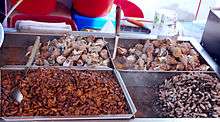
- Dong-nae pajeon (동래파전) is a seafood and green onion pancake, an affordable and popular Busan dish.
- Daegu Tang (대구탕) is a delicious flaky cod soup with vegetables. You will find dedicated restaurants for this at the east side of Haeundae beach.
- Bokguk is a soup made with pufferfish, the type of which is extremely poisonous. It is the same as Japanese Fugu. There are many places in Busan licensed to prepare pufferfish, but you may want to know what you are getting into. Typically there are cartoon pictures of a fish looking like a balloon outside, so should be easy to spot.
Drink
See the Districts articles for more listings.
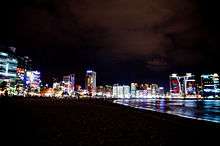
Busan has thousands if not tens of thousands of drinking places scattered throughout the city and popular spots include Nampodong and the area around Pusan National University.
Just look around, and look up, on most streets if you are looking for a bar. Any tall commercial building is likely to have a few inside, usually with English words displayed and often the German word 'Hof' that indicated a place for eating and drinking.
The Kyungsung University area has the most selections in terms of density and sheer numbers of drinking establishments of any area in Busan.
Gwangalli beach in Suyeong is a great place for a drink, especially at night time with the Gwangan bridge lit up over the bay.
In Haeundae, most of the bars that appeal to westerners are on the main street (Gunam-ro) between Haeundae metro station (exit 5) and the beach. Refer to the main Haeundae article for a full list.
Sleep
See the Districts articles for more listings.
- Budget: Many budget options are available in Busan's Haeundae district, Central Busan and Suyeong.
- Love Motels: All sorts of love motels can be found throughout the city, for example near the bus terminals, and can represent a good bargain. Generally ₩30,000-50,000 per night.
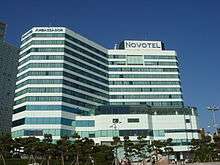
|
Luxury hotels on Busan's Haeundae beachfront
|
- Luxury: Most of Busan's luxury hotels are along Haeundae Beach. Please see the Haeundae article for more details. The hotels there usually offer ocean view and city view rooms, but be prepared to pay extra for the ocean view. Weekend rates are always more expensive than weekday rates, and rates are very high during the summer peak season which varies by hotel but is roughly July to August). Rates can also go up during special events, such as the Busan International Film Festival. Central Busan also has a couple of luxury options.
Connect
- Emergency Numbers
- Police: ☎ 112
- Fire Department: ☎119
- Tourist information Center: 051-253-8253 or 1330
- Gimhae International Airport: 051-463-9457
- Busan Station: 1544-7788
- KTX Reservations: 1544-8545
- Busan Ferry Terminal: 051-465-3471
- Busan Coastal Ferry Terminal: 051-400-3399
- Busan Express Bus Terminal: 051-508-9955
Stay safe
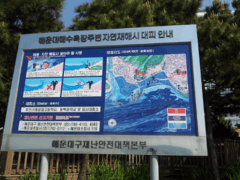
Generally speaking Busan is as safe as most places in South Korea, which is to say very safe.
Busan is very safe to roam around freely at night. Be a little bit cautious when most bars close at around 3AM. Some bars stay open until the business dies down and in many cases this may not be until sunrise. Also take care in the area around Busan Station. If any place could be deemed seedy in Busan (which would be a stretch) this area could be considered so.
On the metro late at night, you may encounter elderly men who are rather vocal, and under the influence of alcohol, who may be unpleasant towards you. This is however unlikely to be dangerous, and you should just move to another metro car.
There are occasionally sand storms from China covering Busan. You should avoid going outside if one passes through.
Driving standards are rather erratic in Busan, even by general Korean standards. Be careful of zebra crossing without traffic lights since they are effectively ignored. Korean women driving large SUVs with mobile phones glued to their ears are a common sight, as are the in-car TV entertainment systems running in many vehicles. Also be wary of scooters/mopeds, since they tend to follow even fewer road rules and are often trying to deliver something very quickly. Switching between sidewalk and road as it suits.)
At the beach
Beaches in Busan do experience riptides, and lifeguard cover outside summer is limited.
There is a tsunami warning system and signs on the beaches, although the risk of a tsunami is far less than in nearby Japan. In the unlikely event a tsunami warning is issued for Busan or the South Korean coastline, head for the top of a tall building or higher ground. Higher ground not being easily accessible on Haeundae Beach.
Every summer the local press gets very concerned about foreigners behaving badly on Busan beaches, usually by photographing Korean girls wearing bikinis, although the same press publishes similar photos of foreign women on Busan beaches. Since it can be a police matter, be careful what pictures you take on the beach.
Cope
Consulates
With Seoul being so close by KTX train, the consulates in Busan do not have a lot to do. The British Consulate appears to have closed. For quick responses you should get your country's Embassy contact details in Seoul.
|
|
Government websites
The Busan government websites often provide useful tourist information in English, but then neglect to maintain them. For example the now discontinued ferry to Geoje island is still listed as a current destination and many links to other English language pages are frequently broken. You should always double check before planning an itinerary.
Busan Haps
An important and up to date resource in English is the Busan Haps online magazine. It is aimed at the expatriate (largely ESL teacher) community, and covers subjects ranging from completely irrelevant (expat opinions on American politics) to somewhat useful (Travel destinations in Seoul and Japan) to very useful (hidden places in Busan off the tourist trail). The event listings will definitely provide some options for you during your stay.
Go next
- Gyeongju - arguably Korea's cultural capital, just over an hour away by bus or direct train
- Geoje - Korea's second largest resort island, now directly accessible by bridge and slightly over an hour away by expressway bus
- Jinju - a quiet city known for its fortress, 1.5 hours away by bus
- Miryang - a peaceful country town and location for many Korean films, 1 hour away by bus or direct train
- Jeju Island - South Korea's favorite domestic vacation spot, reachable in 1 hour by plane or 12 hours by ferry.
- Tsushima island, Japan, makes for a good day trip from Busan.
- Fukuoka is the closest major Japanese city, just three hours away by hydrofoil.
- Japan by rail. You can sail to Fukuoka or Osaka and then use the Japanese Rail network. You can also purchase a Japan Rail Pass at the International Ferry Terminal.
| Routes through Busan |
| Dong-daegu ← Ulsan ← | N |
→ END |
| Dong-daegu ← Miryang ← Gupo ← | N |
→ END |